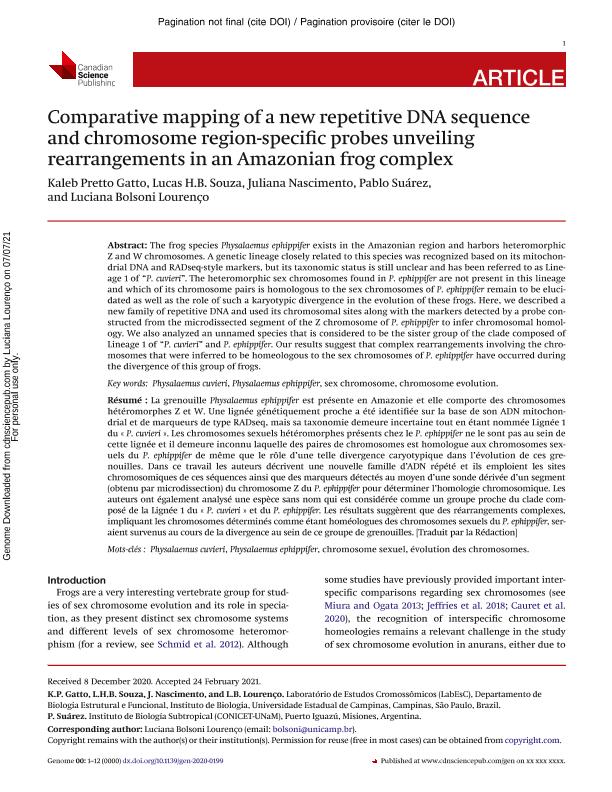Mostrar el registro sencillo del ítem
dc.contributor.author
Gatto, Kaleb Pretto
dc.contributor.author
Souza, Lucas H.B.
dc.contributor.author
Nascimento, Juliana
dc.contributor.author
Suarez, Pablo

dc.contributor.author
Lourenço, Luciana Bolsoni
dc.date.available
2022-03-30T16:56:28Z
dc.date.issued
2021-07
dc.identifier.citation
Gatto, Kaleb Pretto; Souza, Lucas H.B.; Nascimento, Juliana; Suarez, Pablo; Lourenço, Luciana Bolsoni; Comparative mapping of a new repetitive DNA sequence and chromosome region-specific probes unveiling rearrangements in an Amazonian frog complex; National Research Council Canada-NRC Research Press; Genome; 64; 9; 7-2021; 1-12
dc.identifier.issn
0831-2796
dc.identifier.uri
http://hdl.handle.net/11336/154063
dc.description.abstract
The frog species Physalaemus ephippifer exists in the Amazonian region and harbors heteromorphic Z and W chromosomes. A genetic lineage closely related to this species was recognized based on its mitochondrial DNA and RADseq-style markers, but its taxonomic status is still unclear and has been referred to as Lineage 1 of “P. cuvieri”. The heteromorphic sex chromosomes found in P. ephippifer are not present in this lineage and which of its chromosome pairs is homologous to the sex chromosomes of P. ephippifer remain to be elucidated as well as the role of such a karyotypic divergence in the evolution of these frogs. Here, we described a new family of repetitive DNA and used its chromosomal sites along with the markers detected by a probe constructed from the microdissected segment of the Z chromosome of P. ephippifer to infer chromosomal homology. We also analyzed an unnamed species that is considered to be the sister group of the clade composed of Lineage 1 of “P. cuvieri” and P. ephippifer. Our results suggest that complex rearrangements involving the chromosomes that were inferred to be homeologous to the sex chromosomes of P. ephippifer have occurred during the divergence of this group of frogs.
dc.description.abstract
La grenouille Physalaemus ephippifer est présente en Amazonie et elle comporte des chromosomes hétéromorphes Z et W. Une lignée génétiquement proche a été identifiée sur la base de son ADN mitochondrial et de marqueurs de type RADseq, mais sa taxonomie demeure incertaine tout en étant nommée Lignée 1 du « P. cuvieri ». Les chromosomes sexuels hétéromorphes présents chez le P. ephippifer ne le sont pas au sein de cette lignée et il demeure inconnu laquelle des paires de chromosomes est homologue aux chromosomes sexuels du P. ephippifer de même que le rôle d’une telle divergence caryotypique dans l’évolution de ces grenouilles. Dans ce travail les auteurs décrivent une nouvelle famille d’ADN répété et ils emploient les sites chromosomiques de ces séquences ainsi que des marqueurs détectés au moyen d’une sonde dérivée d’un segment (obtenu par microdissection) du chromosome Z du P. ephippifer pour déterminer l’homologie chromosomique. Les auteurs ont également analysé une espèce sans nom qui est considérée comme un groupe proche du clade composé de la Lignée 1 du « P. cuvieri » et du P. ephippifer. Les résultats suggèrent que des réarrangements complexes, impliquant les chromosomes déterminés comme étant homéologues des chromosomes sexuels du P. ephippifer, seraient survenus au cours de la divergence au sein de ce groupe de grenouilles.
dc.format
application/pdf
dc.language.iso
eng
dc.publisher
National Research Council Canada-NRC Research Press

dc.rights
info:eu-repo/semantics/openAccess
dc.rights.uri
https://creativecommons.org/licenses/by-nc-sa/2.5/ar/
dc.subject
PHYSALAEMUS CUVIERI
dc.subject
PHYSALAEMUS EPHIPPIFER
dc.subject
SEX CHROMOSOME
dc.subject
CHROMOSOME EVOLUTION
dc.subject.classification
Biología

dc.subject.classification
Ciencias Biológicas

dc.subject.classification
CIENCIAS NATURALES Y EXACTAS

dc.title
Comparative mapping of a new repetitive DNA sequence and chromosome region-specific probes unveiling rearrangements in an Amazonian frog complex
dc.type
info:eu-repo/semantics/article
dc.type
info:ar-repo/semantics/artículo
dc.type
info:eu-repo/semantics/publishedVersion
dc.date.updated
2022-03-29T19:03:18Z
dc.journal.volume
64
dc.journal.number
9
dc.journal.pagination
1-12
dc.journal.pais
Canadá

dc.journal.ciudad
Otawa
dc.description.fil
Fil: Gatto, Kaleb Pretto. Universidade Estadual Do Campinas. Instituto de Biologia. Departamento de Biologia Estructural y Funcional. Laboratorio de Estudios Cromossomicos.; Brasil
dc.description.fil
Fil: Souza, Lucas H.B.. Universidade Estadual Do Campinas. Instituto de Biologia. Departamento de Biologia Estructural y Funcional. Laboratorio de Estudios Cromossomicos.; Brasil
dc.description.fil
Fil: Nascimento, Juliana. Universidade Estadual Do Campinas. Instituto de Biologia. Departamento de Biologia Estructural y Funcional. Laboratorio de Estudios Cromossomicos.; Brasil
dc.description.fil
Fil: Suarez, Pablo. Consejo Nacional de Investigaciones Científicas y Técnicas. Centro Científico Tecnológico Conicet - Nordeste. Instituto de Biología Subtropical. Instituto de Biología Subtropical - Nodo Puerto Iguazú | Universidad Nacional de Misiones. Instituto de Biología Subtropical. Instituto de Biología Subtropical - Nodo Puerto Iguazú; Argentina
dc.description.fil
Fil: Lourenço, Luciana Bolsoni. Universidade Estadual Do Campinas. Instituto de Biologia. Departamento de Biologia Estructural y Funcional. Laboratorio de Estudios Cromossomicos.; Brasil
dc.journal.title
Genome

dc.relation.alternativeid
info:eu-repo/semantics/altIdentifier/url/https://cdnsciencepub.com/doi/10.1139/gen-2020-0199
dc.relation.alternativeid
info:eu-repo/semantics/altIdentifier/doi/http://dx.doi.org/10.1139/gen-2020-0199
Archivos asociados
